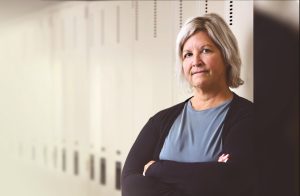By Elizabeth Lokon, Ph.D.
“I joined thinking that I will be helping older people in nursing homes, but they can not imagine how much they are helping me learn about life and about myself.” — Student volunteer
For older people, living in a retirement community can be a lonely existence and those with dementia are often unable to engage in meaningful activities, making them even more isolated.
Developed in 2007 for people living with dementia, Opening Minds through Art (OMA) is an intergenerational art program at Scripps Gerontology Center. Since then, art-making has been shown to bring older people and the volunteers closer, and staff often witness new levels of engagement and expression among residents released from their daily routines.
Every week, student and community volunteers are paired with older people living with dementia in long-term care or adult day communities. Volunteers are trained to support the elders’ freedom to make original art on their own. From this simple premise, we routinely see big changes in the lives of young and old alike. Volunteers typically start out with some degree of apprehension, but by the end of the term, they develop a deep appreciation for the friendships, even kinship, that is created with their elder partners. And staff and family visitors witness new dimensions of social and aesthetic capability they had not seen before in senior participants.
OMA was designed in response to both the elders’ needs for more social engagement and students’ needs for experiences that open their minds. To help students value diversity and appreciate all people regardless of age or cognitive status, it helps to get them out of conventional classrooms and into the community. The opportunity to experience structured and supported interactions with older people on a weekly basis changes their views of aging.
Over the years, program managers have witnessed the growth of genuine and reciprocal relationships that are built across generations. An analysis of student journals and pre- and post-tests of their change in attitudes show that volunteering in OMA contributes to a more positive view toward people living with dementia. This transformation is only possible because of the direct interactions with their older partners.
Students may start the program believing they will be providing a service and helping elders but quickly learn how much they benefit from the experience. They learn important life lessons about paying attention and active listening, about love and respect, about valuing people who are different from themselves. This transforms the elders’ role from care recipients to teachers and artists, which promotes the elders’ well-being.
OMA is now offered at over 200 communities throughout North America. Next year, it will be introduced in Indonesia through Fulbright sponsorship.
Visit https://ScrippsOMA.org to learn more.














